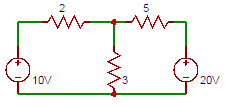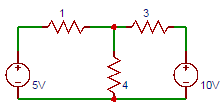1. According to Millman’s Theorem, if there are n voltage sources with n internal resistances respectively, are in parallel, then these sources are replaced by?
a) single current source I’ in series with R’
b) single voltage source V’ in series with R’
c) single current source I’ in parallel to R’
d) single voltage source V’ in parallel to R’
Explanation: Millman’s Theorem states that if there are voltage sources V1, V2,…… Vn with internal resistances R1, R2,…..Rn, respectively, are in parallel, then these sources are replaced by single voltage source V’ in series with R’
2. According to Millman’s Theorem, if there are n voltage sources with n internal resistances respectively, are in parallel, then the value of equivalent voltage source is?
a) V‘=(V1G1+V2G2+⋯.+VnGn)
b) V‘=((V1G1+V2G2+⋯.+VnGn))/((1/G1+1/G2+⋯1/Gn))
c) V‘=((V1G1+V2G2+⋯.+VnGn))/(G1+G2+⋯Gn)
d) V‘=((V1/G1+V2/G2+⋯.+Vn/Gn))/( G1+G2+⋯Gn)
Explanation: The value of equivalent voltage source is V‘= ((V1G1+V2G2+⋯.+VnGn))/(G1+G2+⋯Gn).
3. According to Millman’s Theorem, if there are n voltage sources with n internal resistances respectively, are in parallel, then the value of equivalent resistance is?
a) R’=G1+G2+⋯Gn
b) R’=1/G1+1/G2+⋯1/Gn
c) R’=1/((G1+G2+⋯Gn))
d) R’=1/(1/G1+1/G2+⋯1/Gn)
Explanation: Let the equivalent resistance is R’. The value of equivalent resistance is R’=1/((G1+G2+⋯Gn)).
4. According to Millman’s Theorem, if there are n current sources with n internal conductances respectively, are in series, then these sources are replaced by?
a) single voltage source V’ in parallel with G’
b) single current source I’ in series with G’
c) single current source I’ in parallel with G’
d) single voltage source V’ in series with G’
Explanation: Millman’s Theorem states that if there are current sources I1,I2,…… In with internal conductances G1,G2,…..Gn, respectively, are in series, then these sources are replaced by single current source I’ in parallel with G’
5. According to Millman’s Theorem, if there are n current sources with n internal conductances respectively, are in series, then the value of equivalent current source is?
a) I‘=((I1R1+I2R2+⋯.+InRn))/(R1+R2+⋯Rn)
b) I’=I1R1+I2R2+⋯.+InRn
c) I’=((I1/R1+I2/R2+⋯.+In/Rn))/(R1+R2+⋯Rn)
d) I’=I1/R1+I2/R2+⋯.+In/Rn
Explanation: The value of equivalent current source is I‘=((I1R1+I2R2+⋯.+InRn))/(R1+R2+⋯Rn).
6. According to Millman’s Theorem, if there are n current sources with n internal conductances respectively, are in series, then the value of equivalent conductance is?
a) G’=R1+R2+⋯Rn
b) G’=1/(1/R1+1/R2+⋯1/Rn)
c) G’=1/((R1+R2+⋯Rn))
d) G’=1/R1+1/R2+⋯1/Rn
Explanation: Let the equivalent conductance is G’. The value of equivalent conductance is G’=1/((R1+R2+⋯Rn)).
7. Calculate the current through 3Ω resistor in the circuit shown below.
a) 1
b) 2
c) 3
d) 4
Explanation: Applying Nodal analysis the voltage V is given by (10-V)/2+(20-V)/5=V/3. V=8.7V. Now the current through 3Ω resistor in the circuit is I = V/3 = 8.7/3 = 2.9A ≅ 3A.
8. Find the current through 3Ω resistor in the circuit shown below using Millman’s Theorem.
a) 4
b) 3
c) 2
d) 1
Explanation: V‘=((V1G1+V2G2))/(G1+G2)=(10(1/2)+20(1/5))/(1/2+1/5)=12.86V. R’=1/((G1+G2))=1/(1/2+1/5)=1.43Ω. Current through 3Ω resistor=I=12.86/(3+1.43)=2.9A≅3A.
9. Consider the circuit shown below. Find the current through 4Ω resistor.
a) 2
b) 1.5
c) 1
d) 0.5
Explanation: Applying Nodal analysis the voltage V is given by (5-V)/1+(10-V)/3=V/4. V=6V. The current through 4Ω resistor I = V/4 = 6/4 = 1.5A.
10. In the following circuit. Find the current through 4Ω resistor using Millman’s Theorem. 
a) 0.5
b) 1
c) 1.5
d) 2
Explanation: V‘=((V1G1+V2G2))/(G1+G2)=(5(1/1)+10(1/3))/(1/1+1/3)=6.25V. R’=1/((G1+G2))=1/(1/1+1/3)=0.75Ω. I=6.25/(4+0.75)=1.5A.